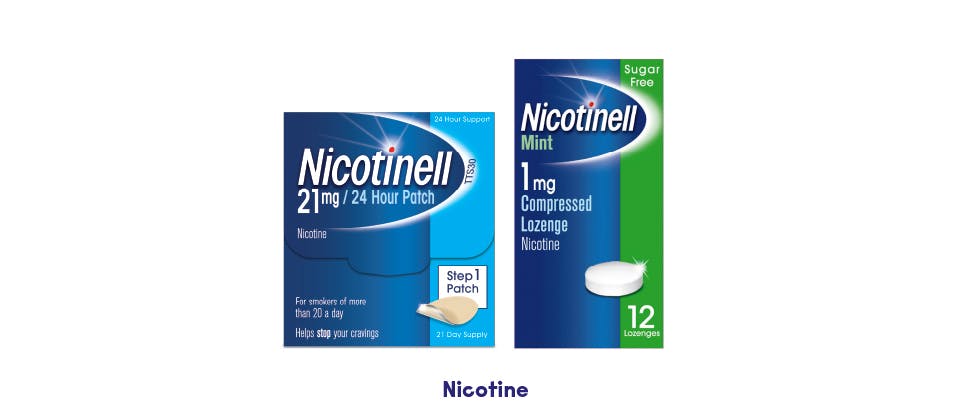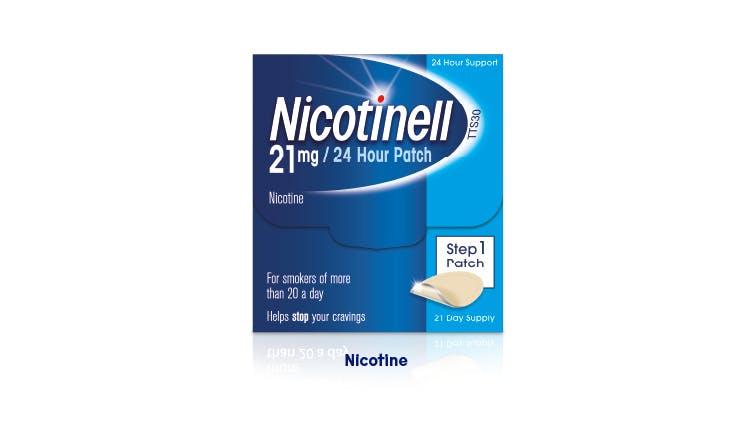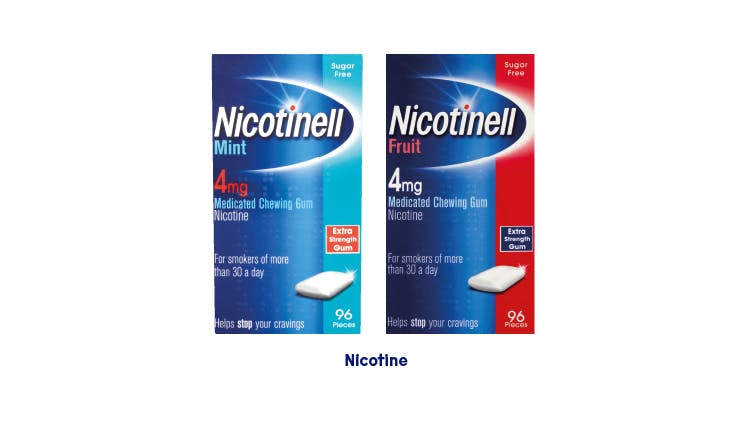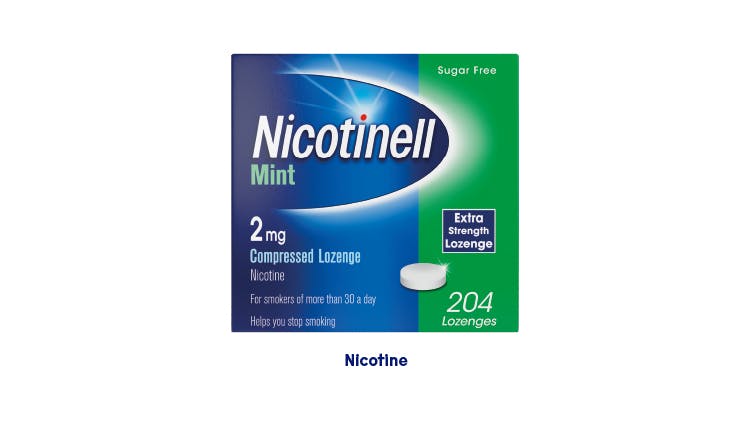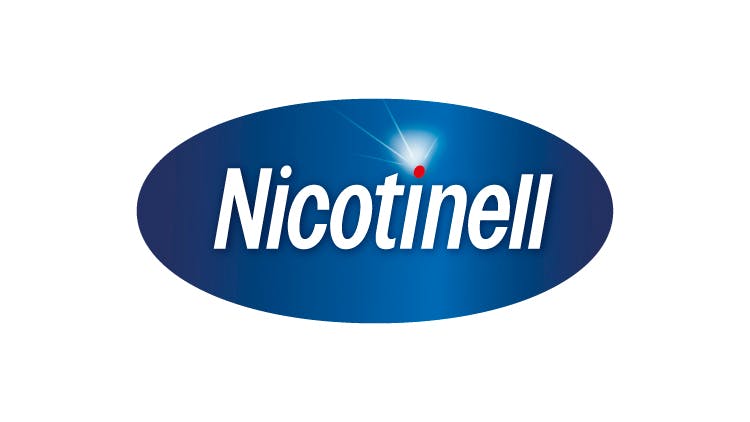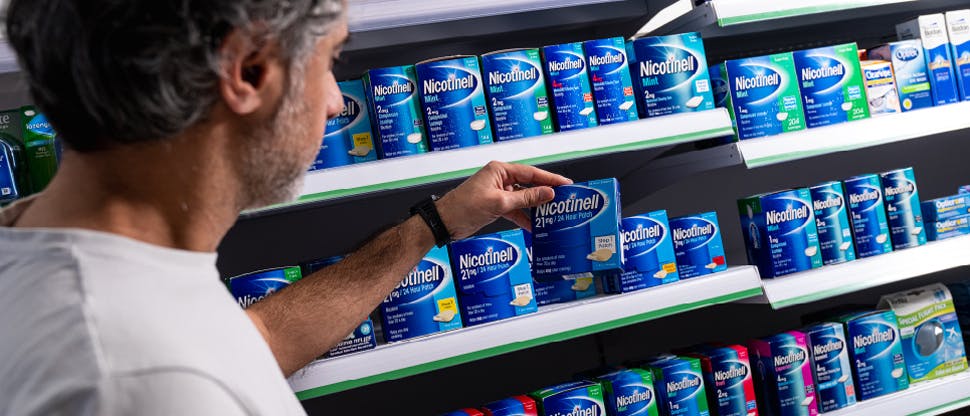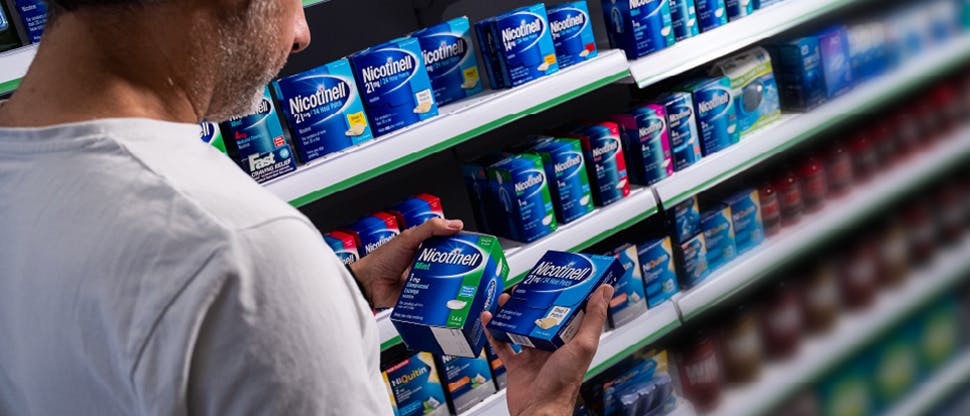Nicotinell Mint 2mg/4mg medicated chewing gum, Nicotinell Fruit 2mg/4mg medicated chewing gum (nicotine polacrilin). Nicotinell TTS 10, Nicotinell TTS 20, Nicotinell TTS 30 (nicotine). Nicotinell Mint 1mg/2mg Compressed Lozenges (nicotine bitartrate dihydrate).
Indications: Treatment of nicotine dependence, as an aid to smoking cessation.
Dosage and method of use: Gum: Adults and elderly: Chew one piece of gum when urge to smoke is felt. Normally 8 to12 pieces per day, up to a maximum of 24 pieces of 2mg gum per day or 15 pieces of 4mg gum per day. Do not use more than 1 gum per hour. After 3 months, gradually cut down the gum usage. The 4mg gum is for those with a strong nicotine dependency. Adolescents (12 to 17 years): As for adults but seek medical advice if more than 12 weeks treatment required. Paediatric population: Not to be used by children under 12 years Patch: Adults: For those smoking ≥20 cigarettes a day: Nicotinell TTS30 (Step 1) once daily. Those smoking <20 start with Nicotinell TTS20 (Step 2) once daily. Reduce nicotine dose over treatment periods of 3 to 4 weeks by reducing patch strength in stepwise fashion. Use continuously for three months, if abstinence not achieved after 3 months further treatments may be recommended. Adolescents (12 to 17 years): Patients under the age of 18 years should seek medical advice before using the product and if treatment is required for longer than 10 weeks. Lozenge: Smoking cessation: Stop smoking completely during treatment. Suck one lozenge slowly. Normally, 8 to 12 lozenges per day, max. Maximum of 24x1mg lozenges per day or 15x2mg lozenges per day. After 3 months, gradually cut down the usage. The higher strength lozenge is for those with a strong nicotine dependency. Smoking reduction: Use to prolong smoke-free intervals to reduce smoking. Gradually replace cigarette number with lozenge. If a cigarette reduction of ≥50 % per day is not achieved after 6 weeks, or quit attempt not made within 6 months of starting treatment seek medical advice. Start quit attempt once ready but no later than 4 months after treatment starts. Gradually reduce lozenge number. Not generally recommended for regular use beyond 6 months. Combination treatment: For when treatment fails with lozenge alone, 1mg lozenge and patch used together for those smoking >20 cigarettes a day, recommended to seek HCP advice. 2mg lozenge not licensed for combination therapy. Start with one patch 21mg/24 hours plus 1mg lozenge (generally 5-6 pieces per day). Max 15 lozenges a day. Treat for 6-12 weeks, then gradually reduce nicotine dose by either 1) reducing patch strength sequentially at 3-6 weeks intervals, then gradually reducing number of lozenges. OR 2) discontinuing use of patches and gradually reducing number of lozenges. Alternate patch application site to avoid skin irritation. Max treatment duration is 9 months. Paediatric population: Not to be used by children under 12 years. Not to be used by adolescents 12-17 years of age without prescription from a healthcare professional.
Contraindications: Known hypersensitivity to nicotine or any of the excipients. Use by non-smokers. Patch and gum: use by occasional smokers. Patch: diseases of the skin.
Precautions: Use with caution in patients with: recent myocardial infarction, unstable or worsening angina including Prinzmetal's angina, severe cardiac arrhythmias, uncontrolled hypertension, or recent cerebrovascular accident who are considered to be haemodynamically unstable, history of epilepsy or those taking anti-convulsant therapy, diabetes mellitus, hyperthyroidism, pheochromocytoma, moderate to severe renal and/or hepatic impairment, active oesophagitis, oral and pharyngeal inflammation, gastritis, gastric/peptic ulcer. Gum: Not recommended for those with jawbone joint problems or denture wearers. May loosen fillings or dental implants. Do not use in patients with hereditary conditions of fructose intolerance. Contains butylhydroxytoluene which may cause irritation to the mucous. Patch: Have a history of dermatitis. Discontinue use if a severe or persistent skin reaction, including allergic reaction, occurs. Nicotinell TTS contains aluminium and should be removed prior to undergoing defibrillation, MRI or cardioversion procedures. Lozenge: Use with caution in patients with: hypertension, stable angina pectoris, cerebrovascular disease, occlusive peripheral arterial disease and heart failure. Contain aspartame, may be harmful to those with phenylketonuria. Do not use in patients with hereditary conditions of fructose intolerance.
Side effects: See SPCs for full details. Gum: Common: nausea, salivary hypersecretion, jaw muscle ache and dyspepsia. Lozenge: Very common: nausea. Common: abdominal pain, insomnia, cough. Gum and Lozenge: Common: flatulence, stomach discomfort, stomatitis, dizziness, headache, hiccups, vomiting, diarhhoea, constipation, dry mouth, oral discomfort and pain, pharyngitis and pharyngolaryngeal pain. Patch: Very common: application site reactions, nausea, insomnia, abnormal dreams, headache, dizziness. Common: agitation, anxiety, nervousness, cough, pharyngitis, dyspnoea, abdominal pain, upper dyspepsia, motor dysfunction, tremor, palpitations, dry mouth, increased sweating, myalgia, asthenia, fatigue, stomatitis, oesophagitis, arthritis, diarrhoea.
Product licence number, legal category, pack size and RSP (excl. VAT): Nicotinell Fruit 2 mg Medicated Chewing Gum, PL 44673/0122: GSL, 96: £16.31, 204: £30.90; Nicotinell Fruit 4 mg Medicated Chewing Gum, PL 44673/0123: GSL, 96: £20.26; Nicotinell Mint 2 mg Medicated Chewing Gum, PL 44673/0126: GSL, 96: £16.31, 204: £30.90; Nicotinell Mint 4 mg Medicated Chewing Gum, PL 44673/0127: GSL, 96: £20.26; Nicotinell TTS 10, PL 44673/0128: GSL, 7: £15.66; Nicotinell TTS 20, PL 44673/0129: GSL, 7: £16.15; Nicotinell TTS 30, PL 44673/0130: GSL, 7: £17.12, 21: £42.09; Nicotinell Mint 1 mg Compressed Lozenges, PL 15545/0003: GSL,12: £3.13, 96: £18.00, 144: £22.68, 204: £25.19, Nicotinell Mint 2 mg Compressed Lozenges, PL 15545/0004: GSL, 96: £20.93, 144: £26.46, 204: £29.48.
PL holder: Gums and Patches: Haleon UK Trading Limited, The Heights, Weybridge, Surrey, KT13 0NY, U.K. Lozenges: GlaxoSmithKline Dungarvan Limited, Knockbrack, Dungarvan, County Waterford, Ireland.
Date of preparation: Jan 2024.


